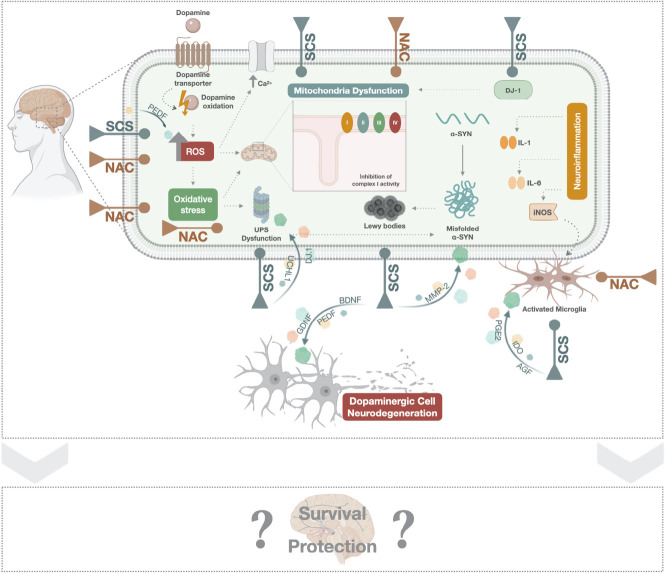Figure 1.
SCS and NAC mechanistic effects.
Administration of SCS (from different sources) was found to significantly reduce ROS production, alpha-synuclein aggregation and as consequence Lewy bodies formation. Still, potential properties in the attenuation of UPS alterations, and mitochondrial dysfunction have also been assigned to SCS, thereby leading to decreased microglia activation and dopaminergic cell death. Trophic factors including PEDF, DJ-1, UCHL-1, GDNF, BDNF, MMP-2, PGE2, and IDO, are responsible for this secretome effects. Similarly, NAC has also revealed the capability to tackle identical mechanisms, such as neuroinflammation, oxidative stress, mitochondria impairments and UPS dysfunction. Despite the multifactorial profile of PD, the multi-targeted approach of SCS and NAC per se or (eventually) in combination opens a promising and reliable therapeutic route to the protection/survival of the preexisting dopaminergic neurons in PD brain lesioned areas, which may lead to the improvement of cellular and molecular mechanisms/circuitries, as well as to functional amelioration. BDNF: Brain-derived neurotrophic factor; DJ-1: protein deglycase; GDNF: glial cell line-derived neurotrophic factor; IDO: indoleamine 2,3-dioxygenase; MMP-2: metalloproteinase 2; NAC: N-acetylcysteine; PEDF: pigment epithelium-derived factor; PGE2: prostaglandin E2; ROS: reactive oxygen species; SCS: stem cells secretome; UCHL-1: ubiquitin carboxyl-terminal hydrolase L1; UPS: ubiquitin-proteosome system.

